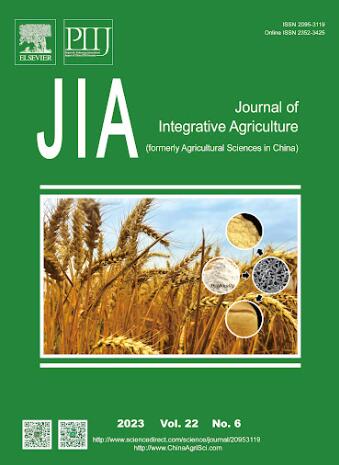Integrated assessment of yield, nitrogen use efficiency and ecosystem economic benefits of use of controlled-release and common urea in ratoon rice production
IF 4.4
1区 农林科学
Q1 AGRICULTURE, MULTIDISCIPLINARY
引用次数: 0
Abstract
Controlled-release urea (CRU) is commonly used to improve the crop yield and nitrogen use efficiency (NUE). However, few studies have investigated the effects of CRU in the ratoon rice system. Ratoon rice is the practice of obtaining a second harvest from tillers originating from the stubble of the previously harvested main crop. In this study, a 2-year field experiment using a randomized complete block design was conducted to determine the effects of CRU on the yield, NUE, and economic benefits of ratoon rice, including the main crop, to provide a theoretical basis for fertilization of ratoon rice. The experiment included four treatments: (i) no N fertilizer (CK); (ii) traditional practice with 5 applications of urea applied at different crop growth stages by surface broadcasting (FFP); (iii) one-time basal application of CRU (BF1); and (iv) one-time basal application of CRU combined with common urea (BF2). The BF1 and BF2 treatments significantly increased the main crop yield by 17.47 and 15.99% in 2019, and by 17.91 and 16.44% in 2020, respectively, compared with FFP treatment. The BF2 treatment achieved similar yield of the ratoon crop to the FFP treatment, whereas the BF1 treatment significantly increased the yield of the ratoon crop by 14.81% in 2019 and 12.21% in 2020 compared with the FFP treatment. The BF1 and BF2 treatments significantly improved the 2-year apparent N recovery efficiency, agronomic NUE, and partial factor productivity of applied N by 11.47–16.66, 27.31–44.49, and 9.23–15.60%, respectively, compared with FFP treatment. The BF1 and BF2 treatments reduced the chalky rice rate and chalkiness of main and ratoon crops relative to the FFP treatment. Furthermore, emergy analysis showed that the production efficiency of the BF treatments was higher than that of the FFP treatment. The BF treatments reduced labor input due to reduced fertilization times and improved the economic benefits of ratoon rice. Compared with the FFP treatment, the BF1 and BF2 treatments increased the net income by 14.21–16.87 and 23.76–25.96%, respectively. Overall, the one-time blending use of CRU and common urea should be encouraged to achieve high yield, high nitrogen use efficiency, and good quality of ratoon rice, which has low labor input and low apparent N loss.对水稻生产中使用控释尿素和普通尿素的产量、氮利用效率和生态系统经济效益进行综合评估
控释尿素(CRU)通常用于提高作物产量和氮利用效率。然而,很少有研究调查控释尿素在轮作水稻系统中的效果。轮作水稻是指从之前收获的主作物茬口上的分蘖中获得第二次收获的做法。本研究采用随机完全区组设计进行了为期两年的田间试验,以确定 CRU 对包括主作物在内的轮作水稻的产量、净效率和经济效益的影响,从而为轮作水稻施肥提供理论依据。试验包括四个处理(i) 不施氮肥(CK);(ii) 传统做法,在不同作物生长阶段通过地表撒播施用 5 次尿素(FFP);(iii) 一次性基施 CRU(BF1);(iv) 一次性基施 CRU 和普通尿素(BF2)。与 FFP 处理相比,BF1 和 BF2 处理使主要作物产量在 2019 年分别显著提高了 17.47% 和 15.99%,在 2020 年分别提高了 17.91% 和 16.44%。BF2 处理与 FFP 处理获得了相似的轮作产量,而与 FFP 处理相比,BF1 处理显著提高了轮作产量,2019 年提高了 14.81%,2020 年提高了 12.21%。与FFP处理相比,BF1和BF2处理显著提高了2年的表观氮回收效率、农艺氮利用效率和施用氮的部分要素生产率,分别提高了11.47-16.66%、27.31-44.49%和9.23-15.60%。与全脂处理相比,BF1 和 BF2 处理降低了主要作物和轮作作物的垩白米率和垩白度。此外,能效分析表明,BF 处理的生产效率高于 FFP 处理。BF处理减少了施肥次数,从而降低了劳动力投入,提高了轮作水稻的经济效益。与全脂处理相比,BF1 和 BF2 处理的纯收入分别增加了 14.21-16.87% 和 23.76-25.96%。总之,应鼓励一次性掺混使用 CRU 和普通尿素,以获得高产、氮利用效率高、品质好、劳动力投入低、表观氮损失少的晚稻。
本文章由计算机程序翻译,如有差异,请以英文原文为准。
求助全文
约1分钟内获得全文
求助全文
来源期刊

Journal of Integrative Agriculture
AGRICULTURE, MULTIDISCIPLINARY-
CiteScore
7.90
自引率
4.20%
发文量
4817
审稿时长
3-6 weeks
期刊介绍:
Journal of Integrative Agriculture publishes manuscripts in the categories of Commentary, Review, Research Article, Letter and Short Communication, focusing on the core subjects: Crop Genetics & Breeding, Germplasm Resources, Physiology, Biochemistry, Cultivation, Tillage, Plant Protection, Animal Science, Veterinary Science, Soil and Fertilization, Irrigation, Plant Nutrition, Agro-Environment & Ecology, Bio-material and Bio-energy, Food Science, Agricultural Economics and Management, Agricultural Information Science.
 求助内容:
求助内容: 应助结果提醒方式:
应助结果提醒方式:


